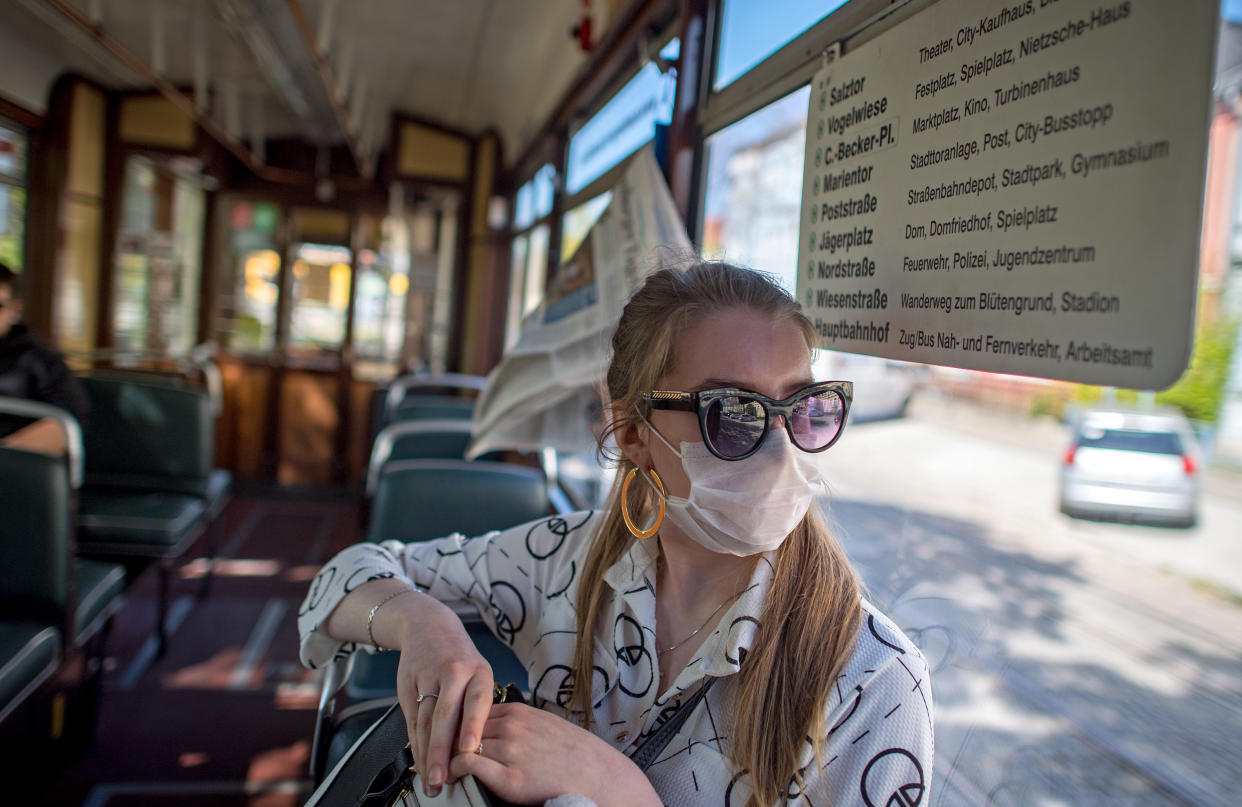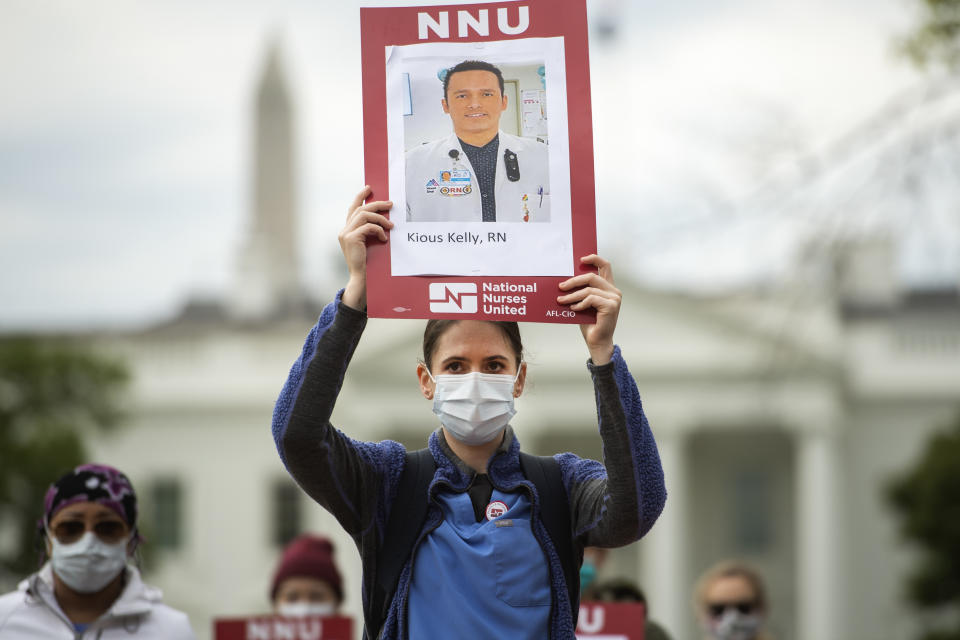Coronavirus: Death data suggests England and Wales peaked on 8 April

Scientists are optimistic that coronavirus-related deaths may have peaked in England and Wales on 8 April.
The data can paint a bleak picture, with the Office for National Statistics (ONS) reporting 18,516 overall deaths on the week ending 10 April, considerably more than the 10,520 average across the past five years.
An analysis by NHS England, however, shows the number of fatalities in hospitals has been falling since 8 April.
NHS England is reporting the date a person died, rather than when the death was recorded. Delays in reports can muddle how fatality rates may be changing.
Early data suggests the coronavirus is mild in four out of five cases, however, it can trigger a respiratory disease called COVID-19.

NHS England data shows about 800 people died with the coronavirus in hospital on 8 April.
The following day it had declined to just over 700 fatalities.
Latest coronavirus news, updates and advice
Live: Follow all the latest updates from the UK and around the world
Fact-checker: The number of COVID-19 cases in your local area
Explained: Symptoms, latest advice and how it compares to the flu
On 14 April, the daily deaths came in at less than 600.
The data shows under 100 COVID-19 deaths were announced on 19 April.
This may change, however, if the deceased are confirmed as being coronavirus positive in post-mortem tests.
“Confirmation of COVID-19 diagnosis, death notification and reporting in central figures can take up to several days and the hospitals providing the data are under significant operational pressure,” according to NHS England.
“This means the totals reported each day may not include all deaths that occurred on that day or on recent prior days”.
The data presented by government officials every day at the 10 Downing Street press briefing is different from ONS or NHS England statistics.
The government and NHS England data is based on hospital cases confirmed by tests, the BBC reported.
The ONS uses death certificates showing both fatalities in hospital and the community across a given week.
Coronavirus: Deaths have not ‘jumped up’ in nearly two weeks
Based on this data, Professor Carl Heneghan from the University of Oxford noted coronavirus-related deaths have not “jumped up” since 8 April.
When asked at a Science Media Centre briefing whether the outbreak may have peaked in England and Wales, he said: “From an epidemiological perspective we can see numbers as consistent with a peak on 8 April.
“[We] have tracked [this] for 13 days and it hasn’t jumped up.”
Writing on The Centre for Evidence-Based Medicine’s website, the “Oxford COVID-19 Evidence Service Team” said: “The peak of deaths is consistent with NHS England’s peak -deaths (8th April) in terms”
Professor Heneghan noted how a similar pattern of fatalities seems to be occurring in other affected countries.
“Country to country we’ve seen a rapid rise up and then [rates] plateau,” he said.
“No country has seen a Doomsday scenario where it keeps accelerating.
“[After] about two weeks [death rates] flatline.”
A chart by the “mortality monitoring in Europe bulletin” that combines fatality data by any cause from more than 20 countries shows a sudden drop off around the week starting 6 April.
Even setting aside the coronavirus, the ONS data suggests “excess” deaths appear to be higher than normal.
Over 18,00 deaths had occurred in England and Wales at the week ending 10 April, nearly 8,000 more than the five-year average.
Of these excess fatalities, more than three quarters (78%) mentioned COVID-19 on the death certificate.
It is unclear if the coronavirus was involved in the remaining fatalities.
At the press briefing, Professor Sir David Spiegelhalter from the University of Cambridge pointed out elderly people may be succumbing to the infection even it is mild and therefore undiagnosed.
Only hospital patients are routinely being tested for the coronavirus.
“Symptoms may not be sufficient [for doctors] to be confident to name [the death] as COVID,” said Sir Spiegelhalter.
Alternatively, people may be wary of going to hospital for a non-coronavirus related incident due to anxiety over becoming infected.
“With limited testing being carried out, it may be that all of the 7,996 excess deaths were directly due to COVID-19, but it is also likely at least some of these were indirectly involved, such as through inability to access typical medical care for other conditions because of COVID-19 activities,” said Professor Martin Hibberd from the London School of Hygiene & Tropical Medicine.
Government officials have stressed people should continue using the NHS for emergencies like a stroke or an asthma attack.

What is the coronavirus?
The coronavirus is one of seven strains of a virus class that are known to infect humans.
Others trigger everything from the common cold to severe acute respiratory syndrome (Sars), which killed 774 people during its 2002/3 outbreak.
Since the coronavirus outbreak was identified, more than 2.5 million cases have been confirmed worldwide, according to Johns Hopkins University.
Of these cases, over 659,700 are known to have “recovered”.
Globally, the death toll has exceeded 171,800.
The coronavirus mainly spreads face-to-face via infected droplets expelled in a cough or sneeze.
There is also evidence it may be transmitted in faeces and survive on surfaces.
Although most cases are mild, pneumonia can come about if the coronavirus spreads to the air sacs in the lungs.
This causes them to become inflamed and filled with fluid or pus.
The lungs then struggle to draw in air, resulting in reduced oxygen in the bloodstream and a build-up of carbon dioxide.
The coronavirus has no “set” treatment, with most patients naturally fighting off the infection.
Those requiring hospitalisation are given “supportive care”, like ventilation, while their immune system gets to work.
Officials urge people to ward off the coronavirus by washing their hands regularly and maintaining social distancing.



